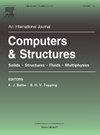Nonlocal stress and J-integral approaches for cohesive crack growth within enhanced DodeQuad virtual element
IF 4.4
2区 工程技术
Q1 COMPUTER SCIENCE, INTERDISCIPLINARY APPLICATIONS
引用次数: 0
Abstract
The aim of this paper is to present a numerical procedure for reproducing the crack growth in two-dimensional (2D) cohesive solids. Two approaches are proposed to determine the direction of crack propagation. One approach is based on the evaluation of the nonlocal stress around the tip of the fracture, while the other on the computation of the J-integral. Once the direction of crack propagation has been determined, a cohesive interface is introduced. The crack evolution is performed by developing a new 12-node quadrilateral enhanced virtual element (VE), denoted as DodeQuad, presenting three different formulations of the element. The new VE is characterized by features that make it particularly suitable for reproducing the crack growth, including its stabilization-free nature, its high degree of accuracy in determining the strain and stress fields, its suitability for the J-integral evaluation, and its ability to define a numerical procedure that does not require the variation of the number of nodes and degrees of freedom during the analysis. This leads to a minimal remeshing requirement for crack propagation. To illustrate the performance of the developed numerical procedure, some numerical applications are performed, including comparisons with available experimental evidence and with other numerical techniques.
增强DodeQuad虚元内聚裂纹扩展的非局部应力和j积分方法
本文的目的是提出一个数值程序来再现二维(2D)粘性固体中的裂纹扩展。提出了两种确定裂纹扩展方向的方法。一种方法是基于裂缝尖端附近的非局部应力的评估,另一种方法是基于j积分的计算。一旦确定了裂纹扩展方向,就引入了内聚界面。裂纹演化是通过开发一种新的12节点四边形增强虚拟单元(VE)来实现的,该单元表示为DodeQuad,提供了三种不同的单元形式。新的VE具有特别适合再现裂纹扩展的特征,包括其无稳定化特性,在确定应变和应力场方面的高度准确性,对j积分评估的适用性,以及在分析过程中不需要改变节点数量和自由度的数值过程的能力。这导致裂纹扩展的最小重网格要求。为了说明所开发的数值程序的性能,进行了一些数值应用,包括与现有实验证据和其他数值技术的比较。
本文章由计算机程序翻译,如有差异,请以英文原文为准。
求助全文
约1分钟内获得全文
求助全文
来源期刊

Computers & Structures
工程技术-工程:土木
CiteScore
8.80
自引率
6.40%
发文量
122
审稿时长
33 days
期刊介绍:
Computers & Structures publishes advances in the development and use of computational methods for the solution of problems in engineering and the sciences. The range of appropriate contributions is wide, and includes papers on establishing appropriate mathematical models and their numerical solution in all areas of mechanics. The journal also includes articles that present a substantial review of a field in the topics of the journal.
 求助内容:
求助内容: 应助结果提醒方式:
应助结果提醒方式:


